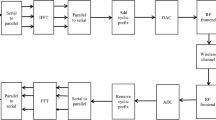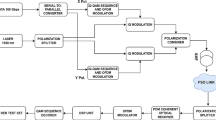Abstract
In this article, we study the effect of peak-to-average power ratio (PAPR) in optical multi-carrier framework communication (OMFC) for 64 and 256-QAM (quadrature amplitude modulation). PAPR is considered a significant problem that significantly degrades the efficiency of the power amplifier. Partial transmission sequence (PTS) is one of the most effective algorithms to lower the high peak amplitude of the structure. The OMFC symbols are weighted with the optimal intelligent PTS phase factor to reduce the high amplitude of the optical waveform, which enhances the efficiency of the system. Parameters such as PAPR, bit error rate (BER), and power spectrum density are also evaluated and analysed. The outcomes of the work reveal that the PTS efficiently reduces the PAPR to 0.4 dB, 1.9 dB, 3.8 dB, and 8.7 dB as compared with selective mapping (SLM), clipping and filtering (C&F), companding, and the original signal for 256-QAM. The PAPR of OMWC for 64-QAM is 11.1 dB, which is decreased by PTS to 1.9 dB, SLM to 3 dB, C&F to 3.3 dB, and the companding technique to 5.2 dB. Further, it also enhances the spectral performance and preserves the BER of the framework.







Similar content being viewed by others
Availability of data and materials
Not applicable.
References
Abdulkafi, A.A., Alias, M.Y., Hussein, Y.S., Omar, N., Salleh, M.K.B.: A hybrid PAPR reduction scheme for optical wireless OFDM communication systems. KSII Trans. Internet Inf. Syst. 12(3), 1136–1151 (2018)
Ahmed, M.S., et al.: An analysis on the conventional partitioning schemes of partial transmit sequence in OFDM systems. Int. J. Adv. Trends Comput. Sci. Eng. 9(14), 167–714 (2020)
Arai, S., Kinoshita, M., Yamazato, T.: Optical wireless communication: a candidate 6G technology? IEICE Trans. Fundam. Electron. Commun. Comput. Sci. 104(1), 227–234 (2021)
Ayeswarya, R., Prabha, N.A.: Fractional wavelet transform based PAPR reduction schemes in multicarrier modulation system. IETE J. Res. 68, 732–742 (2019)
Bai, J., Li, Y., Cheng, W., Yang, Y., Duan, Z., Wang, Y.: PAPR reduction for IM/DD-OFDM signals in underwater wireless optical communication system. In: 2018 13th IEEE Conference on Industrial Electronics and Applications (ICIEA), Wuhan, China, pp. 1837–1840 (2018). https://doi.org/10.1109/ICIEA.2018.8398007
Chakravarty, S., Kumar, A.: PAPR reduction of GFDM signals using encoder–decoder neural network (autoencoder). Natl. Acad. Sci. Lett. (2023). https://doi.org/10.1007/s40009-023-01230-1
Creswell, A., White, T., Dumoulin, V., Arulkumaran, K., Sengupta, B., Bharath, A.A.: Generative adversarial networks: an overview. IEEE Signal Process. Mag. 35(1), 53–65 (2018). https://doi.org/10.1109/MSP.2017.2765202
Diallo, M.L., Chafii, M., Palicot, J., Bader F.: Modified tone reservation for PAPR reduction in OFDM systems. In: 2016 24th European Signal Processing Conference (EUSIPCO), Budapest, Hungary, pp. 697–701, (2016). https://doi.org/10.1109/EUSIPCO.2016.7760338
Dinur, N., Wulich, D.: Peak-to-average power ratio in high-order OFDM. IEEE Trans. Commun. 49(6), 1063–1072 (2001). https://doi.org/10.1109/26.930636
Green, P.J.: Peak-to-average power ratio and power amplifier back-off requirements in wireless transmissions. In: TENCON 2017–2017 IEEE Region 10 Conference, Penang, Malaysia, pp. 630–633 (2017). https://doi.org/10.1109/TENCON.2017.8227938
Hu, C., Wang L., Zhou Z.: A modified SLM Scheme for PAPR reduction in OFDM systems. In: 2020 IEEE 10th International Conference on Electronics Information and Emergency Communication (ICEIEC), Beijing, China, pp. 61–64, (2020). https://doi.org/10.1109/ICEIEC49280.2020.9152350
Jawhar, Y.A., et al.: A review of partial transmit sequence for PAPR reduction in the OFDM systems. IEEE Access 7, 18021–18041 (2019). https://doi.org/10.1109/ACCESS.2019.2894527
Kiambi, S., Mwangi, E., Kamucha, G.: Reducing PAPR of OFDM signals using a tone reservation method based on ℓ∞-norm minimization. J. Electr. Syst. Inf. Technol. 9, 12, 1–15 (2022). https://doi.org/10.1186/s43067-022-00055-0
Kumar, A.: PAPR reduction of FBMC using hybrid and k-hybrid techniques. Radioelectron. Commun. Syst. 62, 501–509 (2019). https://doi.org/10.3103/S0735272719100029
Kumar, A., Gupta, M.: A comprehensive study of PAPR reduction techniques: design of DSLM-CT joint reduction technique for advanced waveform. Soft Comput. 24, 11893–11907 (2020). https://doi.org/10.1007/s00500-020-05086-1
Kumar, A., Rathore, H.: Reduction of PAPR in FBMC system using different reduction techniques. J. Opt. Commun. 42(2), 303–309 (2021). https://doi.org/10.1515/joc-2018-0071
Kumar, A., Bhargav, A., Karthikeyan, A., Rajagopal, K., Srinivasan, A.K., Tsegay, A.N.: Low computational artificial intelligence genetic algorithm assisted SLM PAPR reduction technique for upcoming 5G based smart hospital. In: Malik, H., Iqbal, A., Joshi, P., Agrawal, S., Bakhsh, F.I. (eds.) Metaheuristic and Evolutionary Computation: Algorithms and Applications. Studies in Computational Intelligence, vol. 916. Springer, Singapore (2020)
Kumar, A., Gour, N., Sharma, H., Pareek, R.: A hybrid technique for the PAPR reduction of NOMA waveform. Int. J. Commun. Syst. (2022). https://doi.org/10.1002/dac.5412
Mhatrea, K., Khot, U.P.: Efficient selective mapping PAPR reduction technique. Procedia Comput. Sci. 45, 620–627 (2015)
Niwareeba, R., Cox, M.A., Cheng, L.: PAPR reduction in optical OFDM using lexicographical permutations with low complexity. IEEE Access 10, 1706–1713 (2022). https://doi.org/10.1109/ACCESS.2021.3138193
Noorazlina, M.S., Sulong, S.M., Said, M.S.M., Ahmad, I., Idris, A.: Design of MIMO F-OFDM system model for PAPR reduction in the growth of 5G Network. J. Phys. Conf. Ser. 1793, 012067, 1–15 (2021)
Popoola, W.O., Ghassemlooy, Z., Stewart, B.G.: Pilot-assisted PAPR reduction technique for optical OFDM communication systems. J. Lightwave Technol. 32(7), 1374–1382 (2014). https://doi.org/10.1109/JLT.2014.2304493
Sharif, A.A.: PAPR reduction of optical OFDM signals in visible light communications. ICT Express 5(3), 202–205 (2019)
Sun, Y., Yang, F., Cheng, L.: An overview of OFDM-based visible light communication systems from the perspective of energy efficiency versus spectral efficiency. IEEE Access 6, 60824–60833 (2018)
Taha, B., Fayed, H.A., Aly, M.H., et al.: A reduced PAPR hybrid OFDM visible light communication system. Opt. Quantum Electron. 54, 815, 1–13 (2022). https://doi.org/10.1007/s11082-022-04219-0
Tani, K., Medjahdi, Y., Shaiek, H., Zayani, R., Roviras, D.: PAPR reduction of post-OFDM waveforms contenders for 5G and beyond using SLM and TR algorithms. In: Proceedings of the 2018 25th International Conference on Telecommunications (ICT), Saint-Malo, France, pp. 104–109 (2018)
Xiao, Y., Wen, Q.S., Lei X., Li S.Q.: Improved PTS for PAPR reduction in OFDM systems. In: The Third Advanced International Conference on Telecommunications (AICT’07), Morne, Mauritius, pp. 37–37, (2017). https://doi.org/10.1109/AICT.2007.26
Yadav, S.P., Bera, S.C.: PAPR reduction using clipping and filtering technique for nonlinear communication systems. In: International Conference on Computing, Communication and Automation, Greater Noida, India, pp. 1220–1225, (2015). https://doi.org/10.1109/CCAA.2015.7148590
Yoo, H., Guilloud, F., Pyndiah, R.: PAPR reduction for LDPC coded OFDM systems using binary masks and optimal LLR estimation. Signal Process. 91(11), 2606–2614 (2011)
Funding
There is no funding receive.
Author information
Authors and Affiliations
Contributions
AK: wrote the paper and perform mathematical analysis, NG and NG: perform the editing of the paper; SKY and HS: perform the experiment.
Corresponding authors
Ethics declarations
Conflict of interest
All authors do not have any conflict of interest.
Ethical approval
This article does not contain any studies with human participants or animals performed by any of the authors.
Additional information
Publisher's Note
Springer Nature remains neutral with regard to jurisdictional claims in published maps and institutional affiliations.
Rights and permissions
Springer Nature or its licensor (e.g. a society or other partner) holds exclusive rights to this article under a publishing agreement with the author(s) or other rightsholder(s); author self-archiving of the accepted manuscript version of this article is solely governed by the terms of such publishing agreement and applicable law.
About this article
Cite this article
Kumar, A., Gour, N., Yadav, S.K. et al. A comparative PAPR, BER, and PSD for optical NOMA communication framework. Opt Quant Electron 55, 890 (2023). https://doi.org/10.1007/s11082-023-05148-2
Received:
Accepted:
Published:
DOI: https://doi.org/10.1007/s11082-023-05148-2




